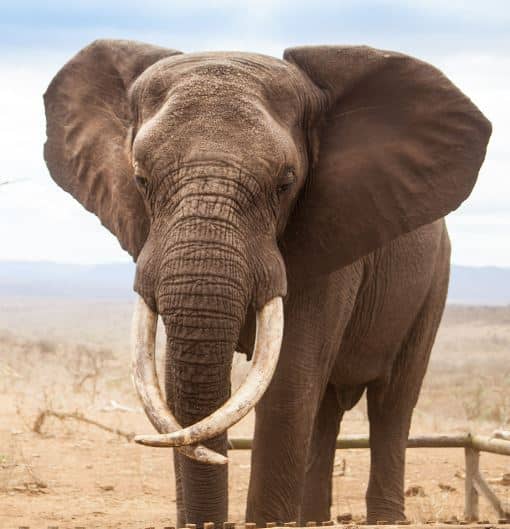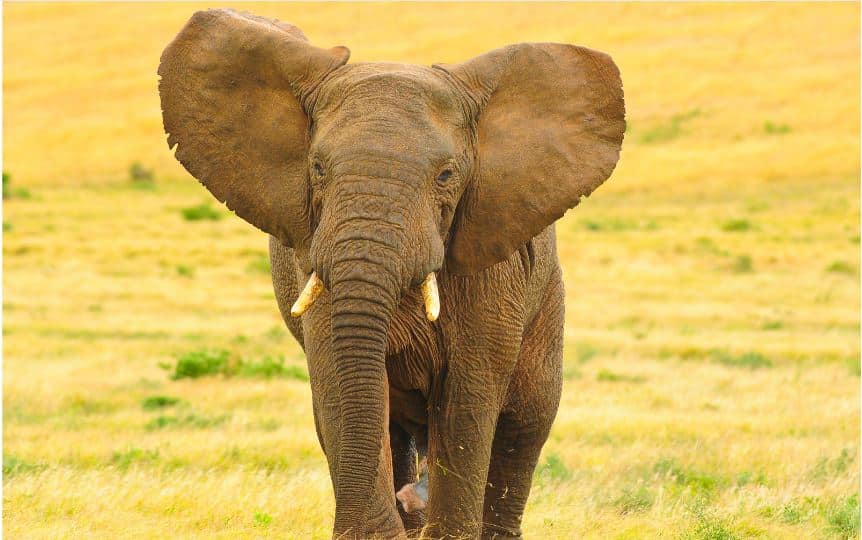What Elephants Hear
On several occasions, I have had the opportunity to visit Africa, and spending time in the welt and/or savanna is mandatory for this outdoorsman. I have experienced unbelievable animal activity – off the beaten tracks, but always in the company of a well-trained and armed ranger/tracker.
How animals hear and communicate is an interesting topic. For some animals, quite a bit has been written, but for others, it appears that observation and then speculation is the order of the day. In other words, most research labs are more likely to be equipped to handle a chimpanzee than a white rhino.
The elephant is one of Africa’s Big 5, along with the lion, Cape buffalo, leopard, and rhinoceros. Most information related to animal communication has been collected on the elephant. Therefore, this blog will start with the elephant.
African Elephant
The hearing range of the elephant is reported in the low frequencies anywhere from 5 to 16 Hz and in the high frequencies from 12,000 to 16,000 Hz (and it should be obvious to hearing professionals that this range was not measured using standard TDH-39 earphones in MX41/AR cushions and the standard headband).
The human ear can hear many elephant sounds, but an intriguing fact is that some of their vocalizations are infrasonic, and thus are inaudible to humans. Sounds are generally considered infrasonic if their frequency is less than 20 Hz (the lower limit of human hearing). Low frequency sounds (long wavelengths meeting little resistance) travel farther than high frequency sounds, which makes them ideal for long distance communication.

The trunk of an adult male may add as much as 2 meters on to the length of the resonating chamber for sound production.
The discovery that elephants use infrasound in communication led from a hunch Katy Payne had when she was working with elephants in Washington Park Zoo in Portland, Oregon. She was studying their communication, when in addition to the rumbles she could hear she thought she felt, rather than heard, other rumbles. She suspected these were infrasonic. Further work with Langbauer, and Thomas showed that the elephants were indeed making infrasonic calls. Subsequent studies took place in Kenya, Namibia, and Zimbabwe, and led to the conclusion that elephants use their powerful deep calls in long distance communication.
Under normal conditions, infrasound allows elephants to communicate and hear messages from distances as great as 2.5 miles, and within almost a 20 square mile range. But, on the savanna, environmental conditions follow a fairly regular diurnal cycle. Around evening a strong temperature inversion usually forms and continues until dawn. This causes low-frequency sound to be reflected back to the ground instead of normally dissipating into the sky. What this means is that, around dusk, especially with cloudless skies and relatively calm weather, elephants can communicate with each other over an even greater distance, and this is when the greatest callings are achieved. Larom et. al. investigated long range calls and atmospheric conditions and found that elephants have the capability to hear from 6 miles distant and within an approximate 40 square mile range when the conditions are right.
Elephants produce a broad range of sounds from very low-frequency rumbles to higher frequency trumpets, snorts, barks, roars, cries, and other idiosyncratic calls. The most frequently used category of calls, at least for African elephants, is the very low-frequency rumble. The fundamental frequency (lowest frequency of a complex signal) within a single elephant call may vary over 4 octaves, starting with a rumble at 27 Hz and graduating into a roar at 470 Hz. Including harmonics, elephant calls may contain frequencies ranging over more than 10 octaves, from a low of 5 Hz to a high of over 10,000 Hz. About 3 weeks ago I photographed elephants at a water hole in the Sabi Sands area of Mpumalanga, South Africa and you can hear the high-frequency trumpet sound near the end:
To get a sense of the range of frequencies used by elephants it may be useful to make a comparison with the range used by humans. Typical human fundamental frequencies for males are around 110 Hz, around 220 Hz for a female, and about 300 Hz for a child. Among elephants, the typical fundamental frequency for a male rumble is around 12 Hz, 13 Hz for a female, and around 22 Hz for a calf.
Elephants can produce very gentle, soft sounds as well as extremely powerful sounds. Some of the calls produced by elephants may be as powerful as 112 decibels (dB) recorded at 1 meter from the source
Elephants do most of their calling in the late afternoon. This is a time when sound transmission is good but is not perfect. An easy explanation for not calling often during the night should be obvious to anyone who has spent the night in the African bush; lions and other predators are awake and hunting at night and it would be foolish to draw unneeded attention, even if you are the “elephant in the room.” Thus, for its survival, elephants have found an ideal balance in maximizing this tool that they are so lucky to possess.
The infrasonic structure allows for distress signals or other communications to be sent and received by other elephants. This ability can be noticed by the sudden reaction of elephants to lift their heads from drinking, bathing, eating, and act in a peculiar fashion. This may indicate that they have heard something that has warned them about some danger, or it could just be a female sending out estrus calls.

Three hundred to 600 pounds of food intake each day keeps elephants constantly on the move.
These findings offer a solution to many old mysteries about elephant society, particularly the mystery attending the ability of males to find females for breeding, and the ability of separated family groups to coordinate their patterns of movement for weeks at a time without losing communication but still converging on the same scarce resources. Not only are the elephants’ low frequency rumbles well suited for long distance communication, but being sounds with a rich harmonic structure, they also allow listening elephants to calculate the distance of the calling elephant. This is because at close range the full harmonic structure will be intact while with increasing distance the upper frequencies will become relatively weaker, eventually leaving only the lower and mid range frequencies to persist.
A structure of the elephant’s ear, the cochlea, may facilitate low- frequency hearing. Elephants are unique among modern mammals (along with dugongs and manatees) in having reverted to a reptilian-like cochlear structure that may facilitate greater sensitivity to lower frequencies. Because the cochlear structure of reptiles facilitates a sensitivity to vibrations, it has been suggested that the similar structure in elephants may allow them to detect vibrational signals as well.
Localization of sound
Elephants are good at localizing sounds. It has been suggested that the larger the space between an animal’s ears (the inter-aural distance), the better the ability at localizing sound. This is because the difference in the time of arrival and the intensity of a sound reaching each ear is used as cues in localizing sound. Elephants are also known to extend their ears perpendicularly to their heads to better localize sounds.
A juvenile Asian elephant was able to localize clicks and noise bursts to within 1 degree, but was not as good at distinguishing tones. Low-frequency tones were more ably distinguished than were higher frequency tones. Below about 300 Hz the elephant was able to localize tones within 10 degrees with 75% accuracy, 20 degrees with about 80% accuracy, and 30 degrees with 90% accuracy.
References
- Payne, K. Silent Thunder: In the Presence of Elephants, Penguin Books, New York, 1999
- Payne, K,; Langbauer, W,; and Thomas, E. (1986) Infrasonic calls of the Asian elephant, Behavioral Ecology and Sociobiology, Vol. 18, No. 4, 297-301
- Larom, D,; Garstang, M.; Payne, K.; Raspet, R.; Lindeque, M. (1997). The influence of surface atmospheric conditions on the range and area reached by animal vocalizations. Journal of Experimental Biology 200 (3): 421-431
- http://www.elephantvoices.org/elephant-communication/acoustic-communication.html
- Payne, K. Silent Thunder: In the Presence of Elephants, Penguin Books, New York, 1999
Wayne Staab, PhD, is an internationally recognized authority in hearing aids. As President of Dr. Wayne J. Staab and Associates, he is engaged in consulting, research, development, manufacturing, education, and marketing projects related to hearing. His professional career has included University teaching, hearing clinic work, hearing aid company management and sales, and extensive work with engineering in developing and bringing new technology and products to the discipline of hearing. This varied background allows him to couple manufacturing and business with the science of acoustics to bring innovative developments and insights to our discipline. Dr. Staab has authored numerous books, chapters, and articles related to hearing aids and their fitting, and is an internationally-requested presenter. He is a past President and past Executive Director of the American Auditory Society and a retired Fellow of the International Collegium of Rehabilitative Audiology.
**this piece has been updated for clarity. It originally published on October 10, 2012








I very much look forward to the other blogs re: nature. Very cool. Thank you .